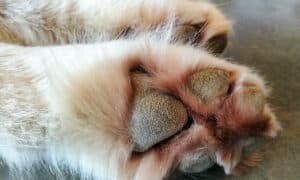“This post contains affiliate links, and I will be compensated if you make a purchase after clicking on my links.”

When Coco, an 8-year old Pit Bull, was stolen from her yard on Thanksgiving, her thieves took some extreme measures to hide the sweet girl’s true identity.
But, when Coco escaped her kidnapper’s home last week, she wound up at Riverside County Animal Services who scanned her for a microchip in hopes of locating an owner.
Luckily, Coco’s family had microchipped their girl when they adopted her just a few months ago.
But, when Heather Lowry arrived at the shelter to pick up her missing pup, she couldn’t help but laugh.
“It was kind of crazy and outrageous to think that somebody would actually go to that extent,” Lowry explained to ABC7. “I laughed, I literally laughed. She looks like a little raccoon. I don’t think she knows she’s a different color. She’s still the same Coco.”
Apparently, in an effort to disguise Coco’s true identity, her dognappers used black or dark brown hair dye all over the dog’s body, completely changing her appearance.
Coco’s adoptive family was smart to microchip their girl and the shelter hopes that other pet parents will do the same. It’s the only way to reliably prove a dog’s identity. And, unlike a dog’s appearance, can’t be altered with supplies from the supermarket.


















Rob
says:As an animal control officer in the Pacific Northwest, I strongly urge you to remind your readers to register their microchips (and keep them updated) with the microchip company. Unfortunately, most people think that once their animal is chipped there is nothing left to do. Sometimes the implanting vet will register the chip for you, but it’s often overlooked. I can tell you from experience that about 35% of the animals we catch are microchiped (way too low, in my opinion), about a third of those have old or inaccurate information, and another third are NEVER registered to the owner. This means that although the microchip is in the animal, we have no proof of ownership and limited ways to track down an original owner.
This is all to say that I would ask that anytime you run an article regarding microchips, you remind your readers to make sure their chips are registered and updated with the manufacturer.